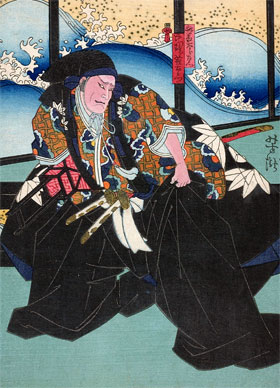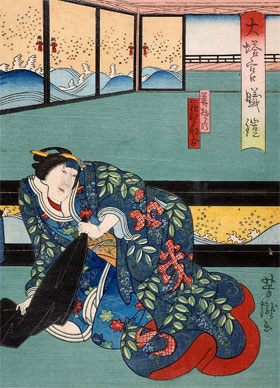| ďTď-NO-MIYA ASAHI NO YOROI |
| Play title | ďt˘-no-Miya Asahi no Yoroi ďt˘-no-Miya and the Armor of the Rising Sun |
|||||||||
| Common title | Migawari Ondo |
|||||||||
| Authors | Takeda Izumo I Matsuda Wakichi |
|||||||||
| History |
The play "ďt˘-no-Miya Asahi no Yoroi" was originally written for the puppet theater (Bunraku) and staged for the first time in the 2nd lunar month of 1723 in ďsaka at the Takemotoza. It was adapted for Kabuki the same year and staged for the first time in the 7th lunar month of 1723 in Ky˘to. It was produced by Ogino Yaegiri I at Hoteiya Umenoj˘'s theater [casting]. It was staged for the first time in Edo at the end of Spring 1760 at the Moritaza (unknown casting). The sekai of "ďt˘-no-Miya Asahi no Yoroi" is the Taiheiki. Asahi no Yoroi means the armor of the rising sun. "ďt˘-no-Miya Asahi no Yoroi" is rarely produced on Kabuki stages nowadays. We've found only 2 records of performances in ˘shibai between 1945 and 2014:
|
|||||||||
| Structure |
The drama "ďto no Miya Asahi no Yoroi" was originally in 5 acts. Only the 3rd act have survived. The first scene, "Rokuhara Yakata" is also called "T˘r˘ Watashi" ("The Handing of the Lantern"). The second and third (and final) scenes, "Nagai Umanokami Yashiki" ("At Nagai Umanokami's Mansion") and "Okuniwa" ("In the Inner Garden") are the most famous scenes of "ďto no Miya Asahi no Yoroi". The last scene is nicknamed "Migawari Ondo" ("The Substitute Dance Music"). |
|||||||||
| Key words |
Bon Bon Odori Genk˘ no Hen Genk˘ no Ran Gidayű Ky˘gen Giri/Ninj˘ Godaigo Tenn˘ Hanagasa H˘j˘ Norisada H˘j˘shi Jidaimono J˘shi Kiriko T˘r˘ Kubioke Migawarimono Moriyoshi Shinn˘ Obon Ondo ďt˘-no-Miya Rokuhara Tandai Rokuhara Yakata Taiheiki Wakamiya Yukata |
|||||||||
| Summary |
At Rokuhara Palace The 1331 uprising, the Genk˘ War, led by Emperor Godaigo against the H˘j˘ clan, which rules Japan, has ended in a defeat for Godaigo and a victory for the H˘j˘. Godaigo was exiled to a remote Island, very far from Ky˘to. Godaigo's son Prince ďt˘-no-Miya (Moriyoshi Shinn˘) is said to have fled to Nara, while Godaigo's wife Sanmi-no-Tsubone and his eight year old boy are being held in custody by Nagai Umanokami Nobuaki in his mansion. Sait˘ Tar˘zaemon Toshiyuki, a H˘j˘ warlord, was credited with much of the victory. His daughter and son-in-law had both sided with Emperor Godaigo and Prince ďt˘-no-Miya and had been killed during the uprising. Meanwhile, Tokiwa Suruga-no-Kami Norisada, a representative of the H˘j˘ clan, has become attracted to the beauty of Sanmi-no-Tsubone. Forgetting his duty, he is involved in finding a way to winning her heart. Instead of speaking to her directly, or writing a letter that might cause scornful laughter among the court ladies, he had decided to win the lady's heart by showing attentiveness to her boy. For this purpose he had sent a group of children to the mansion of Nagai Umanokami, where the lady and child are being held, to perform a traditional summer festival dance (bon odori) to entertain the boy. Then, he has sent as gift to the lady a traditional festival lantern with a message written on it. He has received another summer festival lantern in return from Sanmi-no-Tsubone, with a message written on it as well. Norisada has interpreted this message to mean that she accepts his love. For this reason, he is quite overjoyed. However, although he has tried to visit her, he has not been given an opportunity to meet her. Norisada therefore calls Sait˘ Tar˘zaemon and shows him the lantern that he has received. He also explains the circumstances. Tar˘zaemon shows little interest, telling Norisada that attention should be turned toward war, not romance. Norisada asks Tar˘zaemon to go and bring back the lady to his presence, but the inflexible warrior refuses. At this point, the arrival of Hanazono at the Rokuhara Palace, the wife of Nagai Umanokami, who has come as a messenger sent by Sanmi-no-Tsubone, is announced. She offers greetings from the lady, saying that Sanmi-no-Tsubone is highly pleased with Norisada's elegant messages. She hands over a bundle as a gift to Norisada. It is a garment on which there is a design of waves dashing on the shore, and a ship with full-blown sails. Hanazono tells the excited Norisada that the hidden message is that the lady is the sail receiving Norisada's love, represented by the wind. Norisada is pleased beyond measure. Hanazono goes on to relay the lady's real message: she will bend to Norisada's will but first he must do whatever it takes to get the emperor's release from exile and his return to his palace. Then she will request a separation from Godaigo in order to accept Norisada's love. Norisada is easily fooled, not seeing beyond the surface of message. However, Tar˘zaemon calls him a fool and easily reinterpret the message, which does not mean that the lady is willing to accept Norisada's love. In reality, it is the opposite. If she meant to accept Norisada, then the ship would be shown coming into port. Instead, it is pictured as sailing away with its sails full of the wind. Norisada, finally realizing that he has been fooled, angrily calls for someone to bring a special square-shaped summer festival lantern (kiriko t˘r˘). Then, he asks both Hanazono and Tar˘zaemon about the hidden message that the lantern symbolizes. Tar˘zaemon answers that this square-shaped lantern is called kiriko and that this expression literally means "to cut a child". The message clearly means that Sanmi-no-Tsubone's boy has to be killed. Norisada confirms that Tar˘zaemon's interpretation is correct, and he cold-bloodily orders the warrior to kill the child by that evening. Hanazono, as the wife of Nagai Umanokami who is the custodian of Sanmi-no-Tsubone and her boy, feels that by rights her own husband should be the one to carry out whatever sentence is pronounced against the prisoners. She begs Norisada to entrust the matter to her husband. However, Norisada thrusts her off, and says that Tar˘zaemon will be both the executioner of the boy and the deliverer of the severed head directly to Norisada. After Norisada's exit, Tar˘zaemon is about to go to the Nagai mansion, carrying the lantern which symbolizes Norisada's order to kill the child. Hanazono begs Tar˘zaemon to turn the mission over to her husband but Tar˘zaemon abruptly refuses. Hanazono grabs the lantern from him by force, saying that she will take over the role of j˘shi herself. At Nagai Umanokami's Mansion Nagai Umanokami, although he is a warrior fighting for the H˘j˘ clan, is sympathetic to Sanmi-no-Tsubone and her boy. Noting the messages from Norisada, he believes that his two prisoners will be free to leave his custody soon and that perhaps the exiled emperor might even be allowed to return to his palace. The children sent by Norisada have arrived to perform the traditional summer festival dance. Godaigo's wakamiya is dressed in festival yukata and hanagasa just like all the others boys, including Umanokami's son Tsuruchiyo. Hanazono returns to the mansion, carrying the kiriko lantern. She looks very depressed. Umanokami looks at the lantern and the expression on his wife's face. He immediately realizes what the lantern means. However, he secretly motions his wife to say nothing that might cause any concern Sanmi-no-Tsubone. After the koshimoto and the children have gone off to join the festivities, Hanazono explains the circumstances to her husband. Tar˘zaemon will soon be here to get the head of the wakamiya. Umanokami says that there is only one thing to do: they have to substitute their own son Tsuruchiyo for Sanmi-no-Tsubone's boy! He orders Hanazono to leave immediately the mansion. She will run away and hide in the province of Yamato, taking under her protection both Sanmi-no-Tsubone and her boy. When Tar˘zaemon arrives, Tsuruchiyo, who had been instructed by his parents to replace the wakamiya, greets Tar˘zaemon. However, the warrior says that he is not to be fooled. It is obvious that the boy is none other than Umanokami's son Tsuruchiyo. He says that he will seek out and kill himself the wakamiya. Umanokami sets himself in Tar˘zaemon's way to prevent him from going any further. Sanmi-no-Tsubone comes out and clings to Tar˘zaemon too. She orders Tsuruchiyo to join the others boys, calling him by the name of her own son. Then she chastises Tar˘zaemon, saying that at one time Tar˘zaemon's daughter Hayasaki had been in her service at the imperial palace. She had been discovered in an illicit love affair with Doki Kurando Yorikazu, for which the lovers should both have been killed. They were saved thanks to Sanmi-no-Tsubone's intervention in their favor. It was because of gratitude for this intervention that Hayasaki and her husband had sided with Godaigo during the Genk˘ War. She accuses Tar˘zaemon of ingratitude in his harsh attitude toward her son, now that the situation is reversed. Hanazono calms the lady and then gets closer to Tar˘zaemon. She says that children, unaware of any impending tragedy, are dancing the summer festival dance together. She implores Tar˘zaemon to walk in on the group and strike the victim while he is still dancing, in order to spare him the moment of fear before the fatal strike. The warrior agrees. In the Inner Garden Hanazono and Umanokami have expected Tar˘zaemon to strike their child Tsuruchiyo. However they are amazed to find on the site of the festivities Tsuruchiyo as well as the wakamiya unharmed. The two boys are quickly taken away from the site to safety. Umanokami, realizing now that Tar˘zaemon had meant from the start to spare the prince, asks him why he did not kill Tsuruchiyo instead of some innocent child entirely unrelated to the circumstances. Tar˘zaemon then confesses that the child that he had killed, one of the children in the group of dancers, had been his own grandchild, the son of his daughter Hayasaki and her husband Doki Yorikazu. He was aware that the couple had died in an attempt to protect the fugitives. If the wakamiya is killed, then their death would have been entirely in vain. In order to prevent their deaths from becoming meaningless, he has resolved to spare Sanmi-no-Tsubone's boy, sacrificing his daughter's own son as a substitute. Then, carrying in a kubioke the severed head of the boy who was his own grandson, the H˘j˘ warrior Sait˘ Tar˘zaemon Toshiyuki heads off for the Rokuhara Palace to report that he has accomplished his gruesome mission. |
 |
 |
|
The actors Nakamura Jakuemon I and Ogino Senjo playing the roles of Sait˘ Tar˘zaemon Toshiyuki and Hanazono in the drama "ďt˘-no-Miya Asahi no Yoroi", which was staged in the 5th lunar month of 1868 at the Kita-Horie Ichi-no-Gawa Shibai (ďsaka) (print made by Nakai Yoshitaki) |
|
|
|
| Contact | Main | Top | Updates | Actors | Plays | Playwrights | Programs | Links | FAQ | Glossary | Chronology | Illustrations | Prints | Characters | Derivatives | Theaters | Coming soon | News |